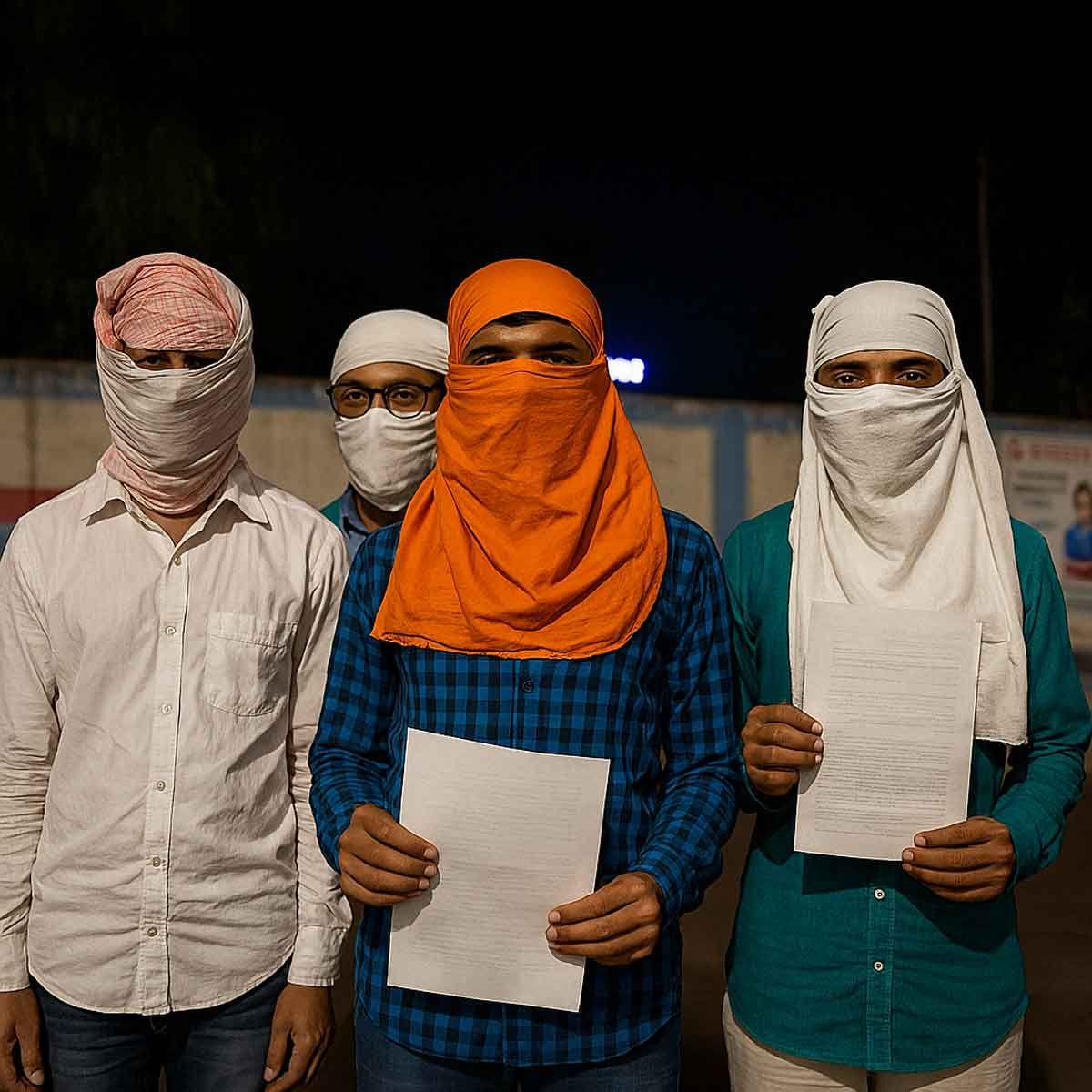More Coverage
Twitter Coverage
Satyaagrah
Written on
Satyaagrah
Written on
Satyaagrah
Written on
Satyaagrah
Written on
Satyaagrah
Written on
JOIN SATYAAGRAH SOCIAL MEDIA
In Telangana's Phanigiri, archaeologists unearth over 3700 Ikshvaku dynasty coins, alongside stone beads, shell bangles, and ancient pottery, illuminating a vivid tapestry of life from the 1st century BCE to the 4th century CE at this historical site

On 29th March, a significant discovery was made at the Phanigiri Buddhist monument in Suryapet district, Telangana, where officials from the Department of Archaeology and Museums unearthed a large cache of lead coins. These coins, dating back to the Ikshvaku period, highlight a rich historical period from the third to fourth centuries of the Common Era. The discovery was made at a depth of two feet, where the team, led by co-excavator B. Mallu and excavation director N. Sagar, found an earthen pot measuring 16.7 cm in diameter and 15 cm in height. Inside this pot were 3,730 lead coins, each adorned with symbols of Ujjain and an elephant, marking their historical significance and origin from opposite sides of the period.
|
Furthermore, this archaeological venture led to the finding of additional relics alongside the coins. Stone beads, glass beads, fragments of shell bangles, stucco motifs, parts of broken limestone sculptures, the wheel of a toy cart, nails, and pottery were also discovered, providing a broader glimpse into the material culture of the time. On 4th April, the Phanigiri site's historical wealth was further acknowledged during a visit by distinguished officials including Shailaja Ramayar, Principal Secretary of the State Archaeology Department, BS Latha, Suryapet Additional Collector, and Bharthi Holikeri, Director of the State History and Heritage Department, underlining the site's archaeological and historical importance to Telangana.
Shailaja Ramayar expressed her excitement about the recent archaeological discovery in Phanigiri, stating, “We have found that the lead coins belong to the Ikshvaku period. This is the first time in the country that so many coins have been found at a single site. It is like achieving a great milestone in uncovering Buddhist history. With this development, the village of Phanigiri has climbed onto the world map.” This statement highlights the significance of the find, not only in terms of quantity but also in its contribution to the historical narrative of the region.
She further detailed the discovery process, saying, “The mouth of the pot was covered with a shallow pot on the outside and a broken base of a bowl on the inside. After opening the pot it came to know that the pot was filled with lead coins. All the coins were taken out from the pot and counted, the coins are three thousand seven hundred thirty (3730) in number and the average weight of each coin is 2.3 grams.” This meticulous recounting of the excavation process shows the careful methods employed by archaeologists to preserve and document their findings.
In addition to the sheer number of coins, their composition and design hold historical value. “They noticed that all of the coins were composed of lead and were similar in nature,” Ramayar observed. Bharthi Holikeri, another expert on the project, pointed out the unique aspects of these coins, explaining, “The coins have an elephant symbol on the obverse and the Ujjain symbol on the reverse. With stratigraphical and typological studies we can come to the conclusion that these coins belong to the Ikshvaku period.” This description underscores the distinctiveness of the Ikshvaku period coins and their cultural and historical importance.
Holikeri also shed light on the broader archaeological context, noting that “Excavations have also been conducted in the past at Vardhamanukota, Gajula Banda, Tirumalagiri, Nagaram, Singaram, Aravapalli, Ayyavaripallim Arlagaddagudem and Yeleswaram, in addition to Phanigiri.” This reveals the extent of archaeological interest and research in the region, with Phanigiri becoming a significant part of a wider network of sites that have been explored to understand the history and heritage of the area.
|
During the extensive excavation at Phanigiri, a plethora of valuable cultural artifacts and structural remnants were discovered, enriching our understanding of the site's historical and cultural significance. Among these finds were beads made of stone and glass, fragments of shell bangles, stucco motifs, pieces of broken limestone sculptures, wheels from toy carts, iron nails, and various pottery items. Each of these artifacts offers a glimpse into the daily life and artistic expression of the people who once inhabited the region.
Phanigiri holds a special place in the history of Buddhism in India, believed to be a significant monastery of the time, perched strategically atop a hill. Its location on the ancient trade route known as Dakshinapatha, which served as a crucial link between the west and east coasts of the Deccan, underscores its importance in facilitating cultural and economic exchanges during ancient times.
The 2023-24 field season marked the eighth excavation campaign at Phanigiri, with archaeological efforts dating back to 2001. These consistent and detailed excavations have played a vital role in unveiling the rich history embedded within this site.
The name of Phanigiri village itself is steeped in local geography and lore, deriving from the distinctive snake hood-like shape of the hillock on which it sits. In Sanskrit, "Phani" means snake, and "Giri" translates to hillock, reflecting the area's physical appearance and its cultural heritage. Research indicates that Phanigiri was a bustling hub of activity and human settlement from as early as 1000 BC until the 18th century AD, making it a site of historical and archaeological marvel spanning over millennia.
Throughout the various stages of excavation at Phanigiri, the Department of Archaeology has unearthed a treasure trove of architectural and cultural wealth. The discoveries include a Mahastupa, apsidal Chaityagrihas (semi-circular prayer halls), Votive stupas (small commemorative monuments), pillared congregation halls where people gathered for religious and social events, Viharas (monastic cells), and platforms with staircases, indicative of the complex's multi-leveled nature. Notably, an octagonal stupa chaitya (a prayer hall with a stupa), a 24-pillared mandapam (a pillared outdoor hall), and a circular chaitya (prayer hall) were also identified. These structures, alongside cultural materials like terracotta and semi-precious beads, iron objects, shell bangle pieces, coins, stucco figures, Brahmi label inscriptions, and a holy relic casket, span a historical period from the 1st century BCE to the 4th century CE, offering a rich timeline of the site's occupation and usage.
|
Phanigiri, located in the Nagaram Mandal of Suryapet district, lies gently beside the Bikkeru rivulet, a tributary of the river Musi. This quaint village, nestled 110 kilometers from Hyderabad and 35 km from the district headquarters in Suryapet, has garnered significant attention due to these archaeological endeavors. The Department of Heritage, Telangana, meticulously carried out the 2023–24 field season excavations, building upon the foundation of previous digs to deepen the understanding of Phanigiri's history and its archaeological footprint.
The extensive earlier excavations at Phanigiri revealed a wealth of artifacts and structures. The findings encompassed not just monumental architecture like Mahastupas and Chaityagrihas but also smaller yet significant elements such as Votive stupas, congregation halls, Viharas, and intricately designed platforms with staircases. These discoveries, coupled with the array of cultural materials including beads, iron objects, inscriptions, and relic caskets, map out a vibrant and dynamic history of the site, showcasing its importance from the 1st century BCE through to the 4th century CE.
The etymology of Phanigiri draws directly from the distinct natural features of its landscape. The name is inspired by the hilltop at the village's northern boundary, which strikingly resembles a snake's hood, leading to its name where "Phani" translates to snake and "Giri" to hilltop in Sanskrit. This nomenclature not only describes the physical aspect of the region but also hints at the deep historical roots embedded within the locale. The area was a vibrant settlement, home to diverse cultures and populations through various historical epochs, ranging from prehistoric or protohistoric times to early historic, early medieval, and extending to the Asaf Jahi period, with a bustling life spanning from 1000 BCE to the late 18th century CE.
Phanigiri is not an isolated archaeological gem; the region is dotted with numerous other significant sites that echo the rich Buddhist heritage of the area. Nearby locations such as Vardhamanukota, Gajula Banda, Tirumalagiri, Nagaram, Singaram, Aravapalli, Ayyavaripalli, Arlagaddagudem, and Yeleswaram also harbor historical treasures waiting to be explored. These sites, like Phanigiri, have been the focus of extensive archaeological scrutiny.
To uncover the layers of history buried in these sites, several field seasons of excavations were systematically carried out. These archaeological endeavors took place during the years 2001–2002, 2002–2003, 2004–2005, 2006–2007, 2010–2011, 2013–2014, and 2018–2019. Each of these field seasons has contributed to the unfolding narrative of Phanigiri and its surrounding areas, shedding light on the rich cultural and historical tapestry that defines this region of India.
Ikshvaku Dynasty (225-340 AD) - A Glimpse into Ancient India's History
The Ikshvaku Dynasty, which flourished between 225 and 340 AD, played a pivotal role in ancient India, especially in the eastern Krishna River valley. From their capital at Vijayapuri, now identified with modern Nagarjunakonda in Andhra Pradesh, the Ikshvaku rulers orchestrated a vibrant period in the region's history. To avoid confusion with their legendary namesakes, they are also referred to as the Andhra Ikshvakus or the Ikshvakus of Vijayapuri. The dynasty's monarchs predominantly practiced Shaivism and adhered to Vedic rituals, yet they presided over a time when Buddhism was also thriving. Notably, many Ikshvaku queens and princes were instrumental in constructing Buddhist monuments at what is now Nagarjunakonda.
In terms of origin, the backstory of the Ikshvaku clan remains a subject of academic debate, with numerous references scattered across historical and religious texts. Inscriptions from Nagarjunakonda, Jaggayyapetta, Amravati, and Bhattiprolu provide evidence of the dynasty's endeavors in realms like donation, construction, religious affiliations, and societal views. The Puranas refer to the Ikshvakus as Andhrabhrtyas (Andhra servants) and Sriparvatiyas (Foresters), with the term 'sriparvatiya' specifically linking their capital Vijayapuri to the ancient Sriparvate Vijaypur, known today as the Nallamalai Range.
The narrative of the Ikshvakus is further enriched by literary works like the Kannada poem Dharmamrita, which posits the Andhra Ikshvakus as descendants of the illustrious northern Ikshvakus of Ayodhya, home to the legendary Lord Rama. Although the accuracy of this claim is contested, it likely served to enhance the dynasty's prestige among their contemporaries. Renowned Oriental scholars, including Buhler and Rapson, have suggested that the northern Ikshvakus migrated southwards, thereby establishing their rule and leaving a lasting legacy in the region's historical and cultural fabric.
 |
 Support Us
Support Us
Satyagraha was born from the heart of our land, with an undying aim to unveil the true essence of Bharat. It seeks to illuminate the hidden tales of our valiant freedom fighters and the rich chronicles that haven't yet sung their complete melody in the mainstream.
While platforms like NDTV and 'The Wire' effortlessly garner funds under the banner of safeguarding democracy, we at Satyagraha walk a different path. Our strength and resonance come from you. In this journey to weave a stronger Bharat, every little contribution amplifies our voice. Let's come together, contribute as you can, and champion the true spirit of our nation.
 |  |  |
| ICICI Bank of Satyaagrah | Razorpay Bank of Satyaagrah | PayPal Bank of Satyaagrah - For International Payments |
If all above doesn't work, then try the LINK below:
Please share the article on other platforms
DISCLAIMER: The author is solely responsible for the views expressed in this article. The author carries the responsibility for citing and/or licensing of images utilized within the text. The website also frequently uses non-commercial images for representational purposes only in line with the article. We are not responsible for the authenticity of such images. If some images have a copyright issue, we request the person/entity to contact us at This email address is being protected from spambots. You need JavaScript enabled to view it. and we will take the necessary actions to resolve the issue.
Related Articles
- In a significant discovery Hindu temple structure with ornate columns found inside a mosque in Mangaluru, locals suspect the presence of a temple in the past: VHP leaders asked to stop work till documents verified
- Delhi court denies interim bail to BRS leader K Kavitha in a high-profile liquor policy scam, stating 'prima facie involvement'; emphasizes her active role in offences, including evidence destruction & influencing witnesses, underscoring the case gravity
- "Haleluya": Pastor R Praveen Kumar and Sharon of Calvary Ministries, Telangana, are accused of cruelty and medical negligence towards a minor with kidney damage, falsely claiming 'miracle healing' abilities, leading to severe legal and ethical concerns
- ASI opposed petition seeking restoration of Hindu and Jain temples inside the Qutub Minar complex, says 'no provision under which Worship can be started': Verdict reserved for June 9
- "Truth is often stranger than fiction": Imagine finding a Shivling in every mosque's fountain!" Maulana Tauqeer Raza muses, stoking controversy over the Gyanvapi structure. Is it truth or clever wordplay? History meets sarcasm in this religious saga
- Telangana police lathi-charge innocent Hindu devotees at Komuravelli Temple during Mahashivaratri, igniting widespread anger against Revanth Reddy govt for violating fundamental & religious rights in Siddipet, Public outcry urges accountability & justice
- "मिज़ाज काफ़िराना": Chilkur Balaji temple priest requests Telangana government to preserve the sanctity of sacred land, as Bajrang Dal protests the construction of a mosque near the revered site, claiming the land was wrongfully labeled as 'Waqf property'
- Karnatak University Dharwad's groundbreaking find in Uttara Kannada uncovers a massive prehistoric rock art site, dating from 1,800 BC-200 AD, featuring unprecedented engravings, marking a monumental discovery in India's archaeological & cultural history
- "जबरदस्ती": Muthyalamma temple idol vandalized in Hyderabad on Oct 14, 2024, just hours after Ram Gopal Mishra was shot dead in Sitapur, Uttar Pradesh; Hindus face relentless attacks—idols desecrated, leaders killed, and protesters like Madhavi arrested
- "यत्र तत्र": Discovered in Maharashtra, a stunning 11th-century Vishnu murti, intricately carved from chlorite schist and depicting the legendary Samudramanthana, ignites local pride and historical debates as Sindkhed Raja and ASI dispute its final home
- "सनातन": In Tamil Nadu's fields, archaeologists uncover a 500-year-old Vijayanagara hero stone, depicting a valiant warrior in battle, echoing the rich legacy of an empire that profoundly sculpted the cultural and historical tapestry of Southern India
- "Chaos Connoisseur": Hindu activist & BJP leader Raja Singh stands strong amidst controversial attacks by Teesta Setalvad, with Telangana polls approaching, Setalvad complaint to the Election Commission sparks debate on political motivations and fairness




























